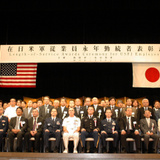Lockheed Martin hopes to cash in by upgrading F-16s

FORT WORTH, Texas — For nearly four decades, the F-16 has ruled the skies in the international market for fighter jet sales, a money-making flying machine for Lockheed Martin and its predecessor, General Dynamics.
Now a number of nations are planning to spend billions to upgrade their fleets of older F-16s with modern “avionics,” digital electronic controls, communications and combat systems.
Lockheed has the inside track to cash in on that business, but faces potentially strong competition.
The announcement last week that the U.S. government had awarded Lockheed a $1.85 billion contract to upgrade Taiwan’s 145 F-16s is the first of what may be several big deals to come in the next year or two.
Already, South Korea has announced plans to contract with BAE Systems to overhaul its 130 F-16s at a cost that has been variously estimated at $750 million to $1.1 billion.
Another potential competitor is Boeing. An official with Chicago-based aerospace manufacturer said it’s interested in the business, since it has gained F-16 experience by converting some of the Air Force’s oldest planes into target drones.
“This is significant work,” said Richard Aboulafia, an analyst with the Teal Group. “Lockheed Martin, for some good reasons and some bad, hasn’t done much to get it.”
Aboulafia estimates that between 1,500 and 2,000 of the 3,000-plus F-16s in operation worldwide could be candidates for upgrade work.
The F-16 upgrade and modification business will generate added revenues for the contractors, but not necessarily lots of U.S. jobs.
Lockheed has said the Taiwan contract would provide continuing work for about 200 of its engineering and electronics people. The company would initially modify several Taiwan F-16s in Fort Worth, but the bulk of the installations would be done in that country with kits of components put together and sold by Lockheed.
BAE has said it will have to add staff in San Antonio to do the initial design, testing and qualification work on the South Korean aircraft and other contracts it might win.
Bill McHenry, Lockheed’s director of F-16 sales, said the company pursued the Korean business and has no idea why that nation chose BAE. Published estimates indicate a far lower price on the Korean planes than what Taiwan is paying, but the scale of work and upgrades may vary by nation.
For any nation looking to upgrade F-16s, McHenry says, Lockheed is the most capable and qualified company to do the work.
“We bring technical assurance. We know the airplane,” McHenry said. “We know the impact of doing things to the airplane. We have the data, the integration labs and we have the people.”
A booming market in F-16 upgrades is not a business opportunity that experts would have predicted just a few years ago.
When the U.S. awarded Lockheed the F-35 Joint Strike Fighter contract in late 2001, the expectation was that F-35s would be rolling off the assembly line in Fort Worth by now and nations would be buying them at about $60 million a copy to replace F-16s.
But the F-35 is years behind schedule and years away from full production, and the future costs of both buying the planes and operating them are uncertain at best.
In the meantime, some core technologies that will be built into the F-35 can now be plugged into existing planes like the F-16.
The key addition is state-of-the-art radars (AESA, or active electronically scanned array) that provide more powerful and accurate search capabilities and are also harder for enemy forces to detect and track.
Northrop Grumman and Raytheon both produce radars, so there’s competition that will bring down costs. The radar is packaged with new mission computers, electronic warfare systems and flat-screen cockpit displays.
For a modest investment (about $13 million per aircraft for Taiwan), nations can now inject much of the F-35’s capability into an F-16 and keep the older birds flying another 15 to 20 years.
“The F-16 is one of the best aircraft ever made. It’s projected to be viable for years to come,” said Floyd McConnell, vice president with BAE’s Support Solutions division.
Lockheed still has orders on the books for about 65 new F-16s, which are being built in Fort Worth at a rate of about one per month. Company officials say they expect to win further orders.
South Korea’s selection of BAE to upgrade its F-16s raised a few eyebrows in the aerospace world. Details of that contract are being worked out between BAE and the U.S. and South Korean governments.
Lockheed was already working with Taiwan and the U.S. Air Force on F-16 modernization plans. The Air Force has said it will equip 300 of its aircraft over the next decade with what Lockheed is now calling the F-16V (for Viper) upgrade, a major technological and combat capability makeover.
McConnell said BAE, which does aircraft maintenance and modification work for the U.S. and other governments, is equally qualified to upgrade F-16s even though the company did not build them. The company has been producing a new mission computer for Air Force and some international F-16s for several years.
“If a country wants all the upgrades Lockheed is offering, BAE can package those capabilities. We can bundle any technology that is available” and install it in the F-16, McConnell said.
BAE is looking to recruit engineers and other experts for its F-16 upgrade team, McConnell said. The company plans to do much of the testing and integration of the major components in Fort Walton Beach, Fla. and San Antonio, and will likely do some initial F-16 upgrade installations in the U.S. as well.
Lockheed isn’t surprised by the likelihood of intense competition for the upgrade business, McHenry said. “We’re a big target just because of the sheer number of F-16s out there.”
What the competitors may lack is the depth of experience and knowledge of how all the pieces fit and work together that Lockheed has gained from 40 years of F-16 development, testing and production.
Once mechanics start disassembling aircraft to remove components and install new ones, they almost inevitably discover new problems that have to be resolved, adding time and cost to the work.
Other companies looking to capitalize on the F-16 upgrade business “don’t know what they don’t know,” said David Nichol, a longtime F-16 engineer for Lockheed and General Dynamics who is now a private consultant in Mansfield, Texas.
“Lockheed,” Nichol said, “doesn’t give away all the secrets of how the systems are integrated.”
Upgrading the F-16
The U.S. Air Force plans to spend about $2 billion to upgrade 300 of its F-16s with a Combat Avionics Programmed Extension Suite, based on the F-16V upgrade package proposed by Lockheed Martin. Each country will specify its own level of upgrades but most will include:
— Active Electronically Scanned Array (AESA) radar. More powerful, faster, versatile and harder to detect and track, AESA radar is the single biggest technology change that vastly improves the F-16 combat capabilities.
— ALQ-213 Electronic Warfare Management System, which lowers the pilot's workload by controlling, monitoring and presenting sensor data from weapons target and threat warning systems.
— Integrated Broadcast Service. Collects and channels communications for various sources into single system.
— 6-inch-by 8-inch flat panel Center Display Unit. Provides a variety of aircraft performance and target information to pilots on a single monitor.
SOURCES: Lockheed Martin, Air Force











